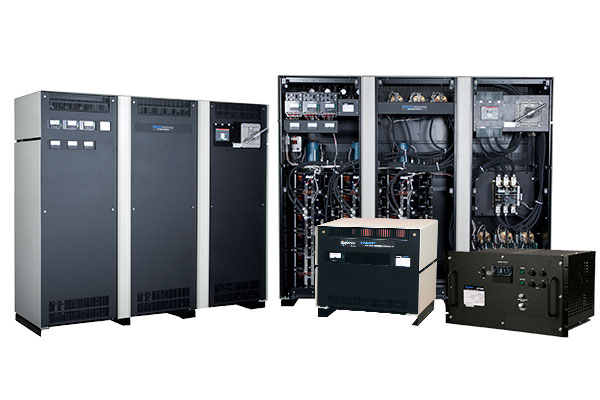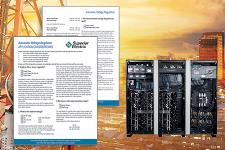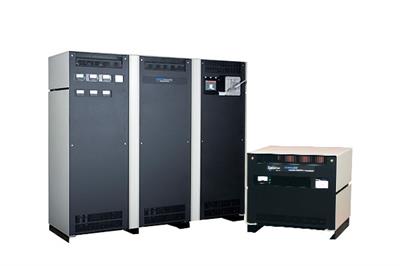Voltage Regulation Solutions Technology Comparison for Power Problems
Voltage regulators help control fluctuating voltages or power supply that could otherwise be be detrimental to electrical machinery. Disturbances such as power sags and surges affect sensitive electronics devices found in vehicles, computers, and battery charging systems to name a few. There are several types of power disturbances that lead to unsafe and sometimes expensive electrical malfunctions. However, the proper voltage regulation technology can help control both sags and surges in voltage, protecting your electrical device.
Types of Power Problems
What is a Power Surge?
A power surge occurs when high voltage electrical loads shut down in short intervals or when electricity is sent back into the system. Surges range in voltage depending on their root cause. A surge, or spike, in power can be strong enough to damage components in electrical devices.
What is a Sag?
A sag, or dip, is a short interval change in low voltage on ac power systems, and is more common than surges. A sag in power supply occurs when electric motors start-up, ground faults, and power systems are undersized.

Types of Voltage Regulation Technology
Tap Switching System
Tap switching technology is the most common solution to electronic voltage regulation. This form of voltage regulation involves a system of taps where all but one are “off”, directing current to flow through only one tap at a time. Tap switching systems are installed on the high voltage windings of transformers, due to low current in that section. Along the system, taps will switch “on” and “off” to increase or decrease the secondary voltage in order to regulate output voltage of a transformer.
Tap switching systems offer several features that allow high performance applications to function properly. Low impedence is required in high performing applications to ensure the circuit can carry the load. Tap switching also offer low harmonic distortion. Increased harmonic distortion can cause overloads, vibration and premature ageing of the transformers as well as increase in the noise level. These and other features allow tap switching systems to deliver 99% typical efficiency, a benefit most other voltage regulation technologies don’t offer.
However, the tap switching system is at a disadvantage to other technologies in that it does not offer 1% accuracy, all load power factors, or full modularity.
| Technology | 1% Accuracy | Shifted Input Range | All Buck / All Boost Operation | Very Low Impedance | Low Harmonic Distortion | All Load Power Factors | Full Modularity | 99% Typical Efficiency |
| WHR Series Regulartor, Limited Range Variable Transformer | Yes | Yes | Yes | Yes | Yes | Yes | Yes | Yes |
| Tap Switching System | No | Some | Some | Yes | Yes | No | No | Yes |
| Constant Voltage Transformer (Ferro) | No | Some | No | No | No | No | No | No |
| Saturable Reactor | Yes | No | No | No | No | No | No | No |
| Variable Transformer with Buck Boost | Yes | Some | No | Yes | Yes | Yes | No | No |
| Induction System | Yes | No | No | No | Load Dependend | Yes | No | No |
Constant Voltage Transformer
A Constant Voltage Transformer (CVT) is highly reliable at neutralizing spikes and electrical noise. This type of voltage regulation technology provides a solid barrier between voltage fluctuations and the main electrical supply of the device.
Compared to other voltage regulation technologies, the advantage of a CVT is that is offers shifted input range. While a CVT does not offer many of the features mentioned in this article, shifted input range is important to mention because line voltages decrease more often than they increase. Therefore, the input voltage range should be broad and shifted for more low correction, rather than high correction. Shifted input range also allows the automatic voltage regulator to be more configurable to all buck or boost, giving it maximum voltage correction for high performance applications.
Saturable Reactor
Saturable reactors send a direct electric current to deliberately saturate the magnetic core of the inductor causing a dramatic dip in the reactor inductance. This type of voltage regulation technology controls the flow of AC power, necessary for driving a loads such as motors, furnaces, and lighting equipment. Saturable reactors can operate in environments that would be harmful to other voltage regulation technologies due to high temperatures or unclean conditions.
The main advatange of a saturable reactor over the other voltage regulation technologies is the 1% accuracy. The lack of moving parts in a saturable reactor allows it to be more reliable than other technologies. This is a great advantage considering the ultimate purpose of a voltage regulator is to achieve accurate levels of voltage.
The drawbacks of saturable reactors include slower response high output impedance which gives high distortion with non-linear loads such as adjustable speed drives. This type of voltage regulation is not ideal for applications, such as motor starting, where currents surge often.
Variable Transformer with Buck Boost
Variable transformers with buck boost are used to regulate voltage applied to alternating current equipment.
With very low impedence and harmonic distortion, the variable transformer with buck boost offers 1% accuracy. This type of voltage regulation technology also has the advantage of all power load factors. Therefore, it is better equipped to handle the electrical demand of high performance applications.
Similar to the CVT technology mentioned abve, the variable transformer with buck boost offers some shifted input range, which is an advantage over the voltage regulation technologies without that feature.
However, the variable transformer with buck boost does not provide operators with all buck/ all boast operation, full modularity or 99% typical efficiency found in some of the other voltage regulation technologies. Whether or not these features are necessary for your application is completely dependent on your unique requirements.
Induction System
Voltage regulation in the form of an induction system provides a continuously variable output voltage for applications in electrical laboratories.
An induction system offers operators the benefits of 1% accuracy and all load power factors. Compared to other regulators, induction systems regulate voltage well under working conditions. This type of voltage regulation is designed for specific applications where features such as, shifted input range, all buck/ all boost operation, very low impedence, or 99% typical efficiency are unnecessary.
WHR Series Stabaline Automatic Voltage Regulators
Automatic voltage regulators serve to automatically maintain a constant voltage supply to sensitive electrical equipment, even when the input voltage and system load vary widely.
Automatic voltage regulators are a simple solution to control line voltage fluctuations. There are several reasons that line voltage may vary, including poor utility line conditions, load-induced line drop, and ever-changing load power requirements. One of the most common signs of fluctuating line voltage is flickering or dim lighting, but it can also cause electric shock in severe cases.
Avoid damage, harm, and malfunctions originating from line voltage fluctuations by implementing an automatic voltage regulator to your sensitive electronic equipment. Typically, automatic voltage regulators are installed between the power source and load to maintain a constant voltage to the load, protect sensitive loads from sags/surges, and balance phase voltages.
The WHR Series Stabaline Automatic Voltage Transformer offers operators critical features, including 1% accuracy, shifted input range, all buck/ all boost operation, very low impedence, low harmonic distortion, all load power factors, full modularity, and 99% typical efficiency.
Equipment downtime, catastrophic equipment failure, software damage, reduced power tube life, and poor signal quality can be avoided. Specify the voltage regulation device that properly meets the requirements of your application.
Learn how variable transformers reduce harmonic distortion
Understand the top 5 features of automatic voltage regulators
Download our selection guide to specify automatic voltage regulators for your application
STABILINE® Automatic Voltage Regulators
STABILINE® Automatic Voltage Regulators for use on all AC power systems, up to 660 volts. The regulator maintains constant voltage to your equipment, even when the input voltage and system load vary widely. The Limited Range coil design allows for substantially higher current and power ratings without increasing unit size or weight.
Learn more »



